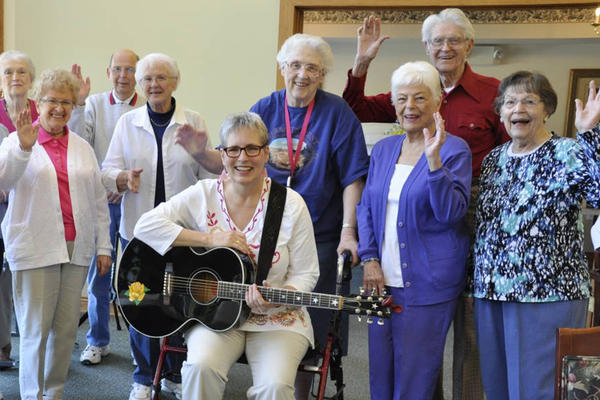Communication
Embracing Person-Centered Dementia Values: The Dementia Action Alliance
One by one, we say hello via video conferencing. We are writers, artists, and arts advocates from all over the country. One sculptor enriches the visual aspects of our meeting by strolling through a museum, giving us occasional glimpses of vibrant art. We meet another artist’s dog. Via video, we see each other’s offices and learn each other’s names and goals. Some of the participants are living with dementia; some are not. All of us are brainstorming ways to use the arts as a catalyst to connect people. Already it is working: through the Dementia Action Alliance, our arts group is already engaging in deep and honest conversation, discussing ways to weave creativity and the arts through June’s conference in Atlanta, and exploring ways we can help others stay connected through the arts.
I have long admired the Dementia Action Alliance and feel honored to be part of their creative process. Their “Person-Centered Dementia Values and Principles” were inspired by the Pioneer Network and have been customized by people living with dementia. Karen Love, Executive Director of DAA, tells us, “Because people who have dementia are the experts, the values are written from their perspective in first person narrative. This orientation helps us focus on what is important.”
Here are some of their core ideas:
Person-Centered Dementia Values and Principles
• I am a person living with dementia. Spend time getting to know me and relating to me as a person with a unique background, life history, interests and capabilities.
• Help me stay connected to what is important to me. Although aspects of my personhood may become increasingly hidden, I am still here.
• A reciprocal relationship is important to me. Autonomy, choices, dignity, privacy, self-determination are fundamental to my well-being.
• Support my holistic emotional, social, physical, cultural, sexual, and spiritual dimensions.
• Promote my personal growth and development. Help me continue to experience purpose, meaning, relationships and enjoyment in my daily life.
• Partner with me, utilize my strengths, and provide the right amount of support and opportunities I need to achieve my goals.
• Some dementia symptoms may interfere with my communication. I communicate the best I can; assume positive intent. Attempt to understand my needs and my reality. Please be compassionate.
For me, reading these principles reminds me how much we are all alike.
For more information on this topic and to learn about the DAA’s upcoming conference:
Conference: Re-Imagine Life with Dementia
You’ll enjoy reading this white paper on Living with Dementia: Changing the Status Quo, DAA
Deborah Shouse is the author of Connecting in the Land of Dementia: Creative Activities to Explore Together and Love in the Land of Dementia: Finding Hope in the Caregiver’s Journey.
Five Tips for Using Music to Connect
Even as a child, I was using music to connect with my parents. My father was a DJ and my mother enjoyed show tunes and old standards. Those songs often played on our record player and we all enjoyed listening. Later, I used that same music to connect me to my mom and dad during her dementia journey.
Today, I am thrilled to sharing the insights of Mary Sue Wilkinson, Founder of Singing Heart to Heart. Just reading her ideas makes me want to burst into song.
Meaningful Visits: 5 Tips for Using Music to Connect
By: Mary Sue Wilkinson, Founder of Singing Heart to Heart
Let’s face it. Visiting someone with Alzheimer’s or dementia can be hard. You want to connect. You want to make them happy. But things have changed. I understand. I’ve been there. I found a way to connect that I’d like to share with you. Let me explain.
My father in law Virgil had dementia and eventually lost all language. The only thing he could say was “gaba gaba.” His face would light up when I came to visit. I think he knew I was someone he loved. But after the first hug and shared smile…I would flounder. Carrying on a one sided conversation only went so far. I would leave feeling lonely and discouraged. I bet he felt the same. As much as I hate to admit it, I began to put off visiting him.
Virgil had been a Church of the Brethren minister. He knew and loved all the old southern gospel songs. One day I took my guitar and began to play and sing for him. I figured I could at least entertain him for an hour or so. I started singing an old favorite: I’ll Fly Away. Virgil lifted his head, broke into a huge smile and began to sing along. Every word. Perfect pitch. He even added harmony From then on music was the focus of our visits.
It didn’t cure Virgil’s dementia. He couldn’t carry on a conversation with me when the song ended. (Although I have seen this happen with others.) But we connected in a meaningful, joyful activity. This was something we could do together. I began to look forward to our visits. I had learned that we could be together without conversation.
Have you ever hesitated to visit someone with dementia or Alzheimer’s because you were afraid you wouldn’t know what to do or what to talk about? Do you feel like you are losing your connection to your loved one or friend?
Music was the “gift” that allowed me to have meaningful, connected, and happy visits with my father-in-law. I hope that it can do the same for you. Here are some suggestions to get you started.
5 tips for using music when you visit someone with dementia
1. When dementia has progressed to the point where conversations are difficult, or even impossible – turn to music. Singing together and/or listening to music can bring happiness regardless of skill or memory. Remember that you are seeking moments of joy and connection. A shared music experience may or may not elicit shared memories. What it will do, is give you a shared experience, in the moment.
2. Bring music with you to your visit – either holiday music or music popular when they were young. Plan ahead and then share it by saying, “I brought some music I thought we could enjoy together.” If the person you are visiting does not have a CD player in their room, bring one from home, borrow one from the activity director or consider purchasing one as a gift. (You can purchase or download my CD of well known songs here.)
3. If you don’t play recorded music, you can simply sing. Even singing one or two songs will lift spirits – for everyone. It’s a great way to establish a positive mood and communicate that you are someone “good.” Choose well known and simple songs such as You Are My Sunshine, My Bonny Lies Over the Ocean, or I’ve Been Working on the Railroad. Or choose well known holiday songs or songs of faith. These songs often evoke the strongest response from people, bringing a powerful connection. (You can download my free song guides here on my website.)
4. Involve your children or grandchildren in planning a musical visit. Give them the job of figuring out what was popular when your loved one was in their 20’s and 30’s and downloading that music to play during the visit. Let them use their smart phone to make a playlist. Do they have a wireless speaker they could bring along?
If your loved one asks for a song you don’t have ready, simply go to You Tube to find it.
5. Add some energy and fun to your musical time together by patting and clapping to the beat. Don’t hesitate to dance. You may be surprised. Sometimes people can dance better than they can walk. Standing or sitting you can still “dance” together and enjoy a sweet connection.
Remember: “When words fail, music speaks.” (Hans Christian Anderson)
 Mary Sue Wilkinson is the founder of Singing Heart to Heart where each year she leads close to 400 singing and music experiences for seniors. She specializes in using music in dementia care. Mary Sue is the author of “Songs You Know By Heart: A Simple Guide for Using Music in Dementia Care” which includes her recording of favorite sing alongs as well as a contribution from Teepa Snow. Learn more and contact Mary Sue at Singing Heart to Heart.com
Mary Sue Wilkinson is the founder of Singing Heart to Heart where each year she leads close to 400 singing and music experiences for seniors. She specializes in using music in dementia care. Mary Sue is the author of “Songs You Know By Heart: A Simple Guide for Using Music in Dementia Care” which includes her recording of favorite sing alongs as well as a contribution from Teepa Snow. Learn more and contact Mary Sue at Singing Heart to Heart.com
Deborah Shouse is the author of Connecting in the Land of Dementia: Creative Activities to Explore Together and Love in the Land of Dementia: Finding Hope in the Caregiver’s Journey.
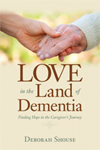

Connect through Movies and Memories
No one said, “Hush,” during the excitement of the paper airplane-flying competition in the Plaza Library. No one put a warning finger to his lips during the spontaneous conversations about favorite childhood foods. And laughing and clapping were encouraged during the two short films and two clips that anchored the Feb 11th Movies and Memory event, an invitation to connect through movies and memories. 
Most of the audience that poured into the Truman Forum that Saturday afternoon could not resist the alluring aroma of the freshly popping corn and stopped to get their free fix. They settled into the comfortable seats and sang along as music therapist and performer Rachelle Norman invited audience members to croon old favorites such as Blue Suede Shoes and Tennessee Waltz. Then they enjoyed two Oscar-nominated shorts, Paper Man and The Feast. 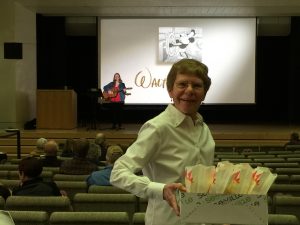
Everyone stood and walked through a waltz, guided by a ballroom dance instructor, after a romantic clip from Cinderella’s ballroom scene. After the final rousing cinematic scene, Marian the Librarian from The Music Man, everyone smiled as volunteers handed out cozy heart-shaped boxes of Russell Stover’s chocolates and shining red carnations. 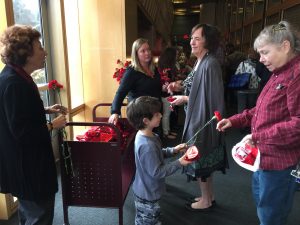
“What a great way to end the week,” one of the caregivers said.
Later, Michelle Niedens, Education Director at the Heart of America Chapter of Alzheimer’s Association, said, “I don’t know whether we have more fun planning these events or participating in the events.” All of us on the planning team agreed. This partnership with the Kansas City Public Library, the Alzheimer’s Association, the Kansas City FilmFest, and The Creativity Connectiong (me and Ron) is filling us all with hope and joy. Our quest to create a dementia and family friendly film series is happening and we are delighted. It’s free of charge, offering families a lovely way to have an uplifiting and interesting experience together.
Don’t miss our next event on April 9th, 1:30 at the Plaza Library. We are thrilled to be part of the Kansas City FilmFest. and we are planning some lovely surprises for our attendees. 
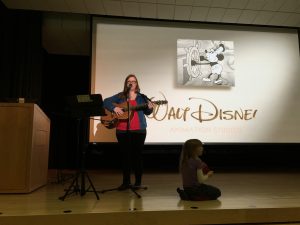
For additional information visit: www.kclibrary.org/signature-events/movies-and-memories-annie
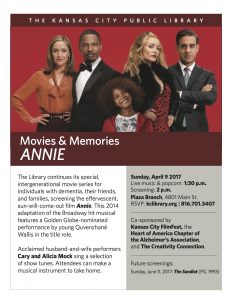
Finding Meaningful Memory Care
“I feel like I’ve been on extended vacation,” Ron’s father Frank said, after his first day in a memory care facility. “Today was really enjoyable.” Ron and I just melted with happiness. We had visited many facilities, with the hope of finding meaningful memory care with great activities. Frank couldn’t have said anything nicer.
It’s quite an emotional journey, finding meaningful memory care. I asked my friend, Dr. El, Dr. Eleanor Feldman Barbera, PhD, author of The Savvy Resident’s Guide and a columnist for McKnight’s Long Term Care News, for some tips.
Finding Meaningful Memory Care With Engaging Activities
“Remember, everything is an activity,” says Dr. El. She encourages care partners to seek a community with a dedicated memory care program, so people with cognitive impairments can benefit from all the offered activities.
“In a specialized unit, staff are trained to work with people who are living with dementia,” Dr. El says. “This training can help people enjoy greater independence.”
In one facility, a lady liked to wander into people’s rooms and take their jewelry. Rather than getting upset, the staff understood, framed this as “shopping,” and simply returned the jewelry.
“These kinds of insights create a calmer, slower-paced environment that reduces agitation,” says Dr. El.
Seek Structure, Soothing and Variety
Here are some things to look for, as you visit facilities:
- Is there a home-like atmosphere?
- Is there a structure to the day?
- Are there calming activities scheduled for change of shift? Changing shift is disruptive, so some communities orchestrate a teatime with music or other soothing activities.
You’re also making sure there are a variety of activities throughout the day. These should include:
Outdoor Time: Taking people outside makes a big difference in mood, appetite, and the sense of connection to the world.
Movement: Exercise is an important component to health.
Nurturing: Look for activities that make people feel confident and good about themselves, such as spa days or activities that incorporate skills such as cooking, art or gardening, modified to provide a “success” experience.
Engagement: Being engaged, rather than just entertained, inspires a sense of purpose, creativity, and social connection.
Kindness is Everything
“Meet with the recreational therapist,” Dr. El suggests. “Is she compassionate and caring? Are the staff members kind? You can have all the activities in the world but if they’re not done with gentleness and humanity, they won’t work.”
Let the recreation director know what your loved one likes to do and see if she can adapt the activity.
Stay Involved
Visit as often as you can and attend activities together. Encourage friends and relatives to join you. Meet other residents and get to know the families and staff.
“You can act as a connector to create friendships, so residents engage in their own interaction, even when you aren’t there,” Dr. El says.
For more information, visit Dr. Eleanor Feldman Barbera, PhD, http://www.eldercarewithdrel.com,
Treat yourself to Dr. El’s book, The Savvy Resident’s Guide
Insider’s Tips for Analyzing Activities Programs
My mother had been an artist in her later years, but she stopped painting when she began living with memory loss. Instead, she took comfort in listening to music and in nurturing a baby doll. Ron’s dad studied architecture as a young man, but never had the leisure time to pursue drawing or art. When he moved into a memory care community, he flourished in the Memories in the Making painting program. We worked hard to find care homes that nurtured our parents and my background in healthcare helped us develop a few insider’s tips for analyzing activities programs.
“Families need to share information about favorite hobbies and they also need to be ready for their loved one to try new things and possibly change interests,” says Alisa Tagg, President of the National Association of Activity Professionals. Alisa has helped dozens of facilities build meaningful activity programs.
Here’s an example of how one woman thrived on learning a new skill and giving back:
Mary’s family was amazed when she got involved in a jewelry-making class in the memory care unit. Mary had never thought of making jewelry and she never even wore necklaces, bracelets, or earrings. But she loved beading and was thrilled to share her creative designs with others. Producing something beautiful for others motivated Mary. The facility helped her sell her jewelry and she contributed the money to the activities budget and also donated to charity.
Alisa knows how emotionally challenging it is for families to find good care facilities for their loved ones. Here are some of her insider’s tips for analyzing activities program.
See For Yourself
“You have to view what is going on in the activity room,” she says. “See how the staff interacts with the residents. If there’s an entertainer, is the staff in the back of the room, charting and talking? Or are they in the front, dancing, and singing and engaging with residents and families?”
Look at the activities calendar. Visit the facility at different times and on various days and see if the activities in progress match the scheduled events.
Encourage Engagement
Study the schedule to see how often the residents are engaged, rather than just being entertained. Are they invited to contribute to community service projects? Are they going to sing-alongs or helping with baking projects? People with memory deficits need a variety of activities. Look for a variety of programming that balances the four areas of wellness—spiritual, mental, physical, and emotional.
Visit Programs of Interest
Visit the programs you think your loved one might enjoy.
Find out how many staff members assist in the activities program.
Does the care staff seem aware of the importance of activities? Is there one-on-one assistance for those who want to participate and need extra attention?
Watch for Independent Projects
Is there a place for puzzles, games, cards, and other things people can enjoy independently? Are there opportunities for residents to contribute to their community and to help others around them?
Share Questions and Concerns
“Every facility should have a plan of care meeting, where family can share their expectations and concerns with the nursing staff,” Alisa says. “Ask how your loved one is doing. Share your insights.
A good facility will welcome that meeting.”
Stay Involved
Stay as involved as you can. Helping your loved one connect through meaningful activities may involve trial and error. Get to know the other residents and their families. You’ll stay engaged with your loved one and create a sense of community with a lot of other wonderful people as well. #
To learn more about Alisa Tagg, BA ACC/EDU AC-BC CADDCT CDP and the National Association of Activity Professionals, visit https://naap.info
To delve into creative activities do you can on individual visits, read my latest book, Connecting in the Land of Dementia: Creative Activities to Explore Together.
Making a Difference, One Island at a Time
 “We are here to explore meaningful ways to stay connected throughout the dementia journey. We are all going to take what we’ve learned and we need the commitment of all of you to help us reach out to the families living with dementia in our communities,” Raymond Jessurun said when he introduced us at a gathering of healthcare professionals, family caregivers, and government representatives. Raymond, who is Secretary of the St. Maarten Alzheimer’s Foundation, is a passionate and inspiring speaker. He urged everyone to join as volunteers of the Alzheimer’s Foundation to spread the meaningful engagement throughout the island, making a difference, one island at a time.
“We are here to explore meaningful ways to stay connected throughout the dementia journey. We are all going to take what we’ve learned and we need the commitment of all of you to help us reach out to the families living with dementia in our communities,” Raymond Jessurun said when he introduced us at a gathering of healthcare professionals, family caregivers, and government representatives. Raymond, who is Secretary of the St. Maarten Alzheimer’s Foundation, is a passionate and inspiring speaker. He urged everyone to join as volunteers of the Alzheimer’s Foundation to spread the meaningful engagement throughout the island, making a difference, one island at a time.
As a group we discussed many engaging activities, including the joy of singing, the nurturing that animals can offer, the power of looking at art, and the creative conversations that cooking together can inspire. We strategized adding more laughter into the day and the importance of knowing each person’s musical preferences. We were also learned of the challenges family caregivers face, which in residential settings as in the Sint Martin’s Home are being addressed by professional caregivers.
 Our host, Bregje Boetekees, Director of the White and Yellow Cross Care Foundation in St. Maarten, was deeply tuned into the importance of offering an array of individualized activities and to the comfort that nature brings to those who are living with dementia. She is overseeing the construction of a new elderly care facility with a large courtyard that will offer safe and ready outdoor access, as well as fertile ground for gardening and other nature-based activities.
Our host, Bregje Boetekees, Director of the White and Yellow Cross Care Foundation in St. Maarten, was deeply tuned into the importance of offering an array of individualized activities and to the comfort that nature brings to those who are living with dementia. She is overseeing the construction of a new elderly care facility with a large courtyard that will offer safe and ready outdoor access, as well as fertile ground for gardening and other nature-based activities.
As always, we left feeling inspired by each of the people we met. Bregje and her team are constantly exploring ways to enrich the lives of their residents who are living with dementia. Raymond and the board members of the Foundation are an example of how a few compassionate and determined people can make a difference. Just eight years ago, Raymond was struggling to find his mother-in-law the dementia care she needed. His advocacy attracted other caregivers and this year their Foundation, which is recognized by Alzheimer’s Disease International, celebrates its seventh year of serving the community. In June, Raymond is co-coordinating a gathering of leaders of Alzheimer’s organizations of 15 Caribbean countries as a step to forming Alzheimer’s Caribbean. These advocates are making a difference, one caregiver at a time, one facility at a time, one island at a time.
###
We invited everyone to join us in Dr. Madan Kataria’s Ha Ha chorus. Watch this and please, sing and laugh along. Click here to view the St. Maarten HaHa Chorus
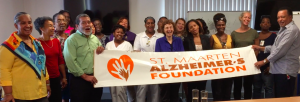
For more about Laughter Yoga, visit Madan Kataria’s website, http://laughteryoga.org
Deborah Shouse is the author of Connecting in the Land of Dementia: Creative Activities to Explore Together and Love in the Land of Dementia: Finding Hope in the Caregiver’s Journey.
Five Ways to Make Valentine’s Day Special for a Loved One with Dementia
My parents liked to celebrate Valentine’s Day with dinner and dancing. Years into my mom’s Alzheimer’s journey, my parents’ love hadn’t diminished, but my mom’s capacity for going out to dinner and dancing had drastically decreased. I saw how blue my father was—one more event he had to give up, one more change in the woman he loved—and I searched for alternatives that might cheer him up. Here are five ways to make Valentine’s Day special.
Look for a favorite thing. Seek one simple pleasure your loved one might enjoy. Mom loved potato soup and chocolate and fresh strawberries. These were part of our celebration.
Nurture yourself: include your own favorite thing. Bring yourself into the celebration and include something that makes you happy. I brought foods my father and I both liked as part of our little party.
Pick several ways to express your love. Poetry, music, gifts, flowers, and photo albums—you can use any of these resources as a catalyst to talk about your feelings. Dad and I sang Mom old show tunes and love songs, music she really enjoyed. Mom adored Shakespeare; we had a couple of sonnets on hand. She and Dad had once created a beautiful flower garden; Dad brought her a single red rose.
Take joy in the simple act of expressing yourself. Being with my mom was a chance to really practice the mythical “unconditional love.” Mom couldn’t tell me she loved me. During one Valentine’s Day celebration, she fell asleep while I was holding her hand and talking sweetly to her. But there was a comfort in expressing my love and I kept on talking.
Celebrate love in all its glorious guises. During their long marriage, my father had walked into a room millions of times and often, Mom had been busy and hadn’t particularly smiled or remarked. But with her dementia came a deep dependency on Dad. When Dad walked into a room, my mother’s face lit up. My father basked in that light. The sparkle in my mother’s eyes was the new, “I love you, darling.” The light said everything my mother could no longer say.
Deborah Shouse is the author of Connecting in the Land of Dementia: Creative Activities to Explore Together and Love in the Land of Dementia: Finding Hope in the Caregiver’s Journey.
Using Creativity to Live Successfully with Dementia
“Creativity is evident in every one of us,” says Michelle Niedens, Director of Education, Programs and Public Policy, Alzheimer’s Association Heart of America Chapter. Every time I hear Michelle talk about the creative aspects of living with dementia, I am moved. I was so honored to have Michelle speak at my book launch for Connecting in the Land of Dementia. I treasured what she said about using creativity to live successfully with dementia and I asked if she would allow me to share her words of wisdom and caring with you. Here is her beautiful talk.
Using Creativity to Live Successfully with Dementia
by Michelle Niedens
It has been said that “we are helped by what is not, to use what is”. In Alzheimer’s disease, there are some things that are not. But welcoming this philosophy of using what is allows us to explore all the parts that are. As part of projects focusing on creativity at the Alzheimer’s Association, I have heard many people talk about how they are not creative. In one way or another, they find a way to let me know they believe they cannot create art, or stories or a collage or whatever forms of creation lay before them. Yet if we allow our minds to really think about the place of creativity in our lives, we could make a case that it is evident in every one of us. Whether it be building book shelves, writing poetry, the way we frame our words in conversation, the way we problem solve, the way we play with children, the way we garden and even the way we convince ourselves of things. Life is both complicated and simple and requires creativity to survive. It is almost as ever present as thought and breath.
In the poem, “the Necessary Art of Salvaging”, Barbara Lau writes;
Live Well with Dementia: The Pygmalion Effect
“This is one of my favorite songs. What do you think of it, Fran?” We were sitting in Mom’s room in the memory care community, listening to a recording of The Very Thought of You. Even though my mother could no longer answer this question, I liked hearing my father ask it. He honored Mom as his long-time beloved conversational partner. Through this simple action, he was helping her live well with dementia. His example helped me do the same.
 This article by Karen Love, Executive Director of Dementia Action Alliance, reminded me of my dad’s positive outlook. It inspired and touched me and I wanted to share it with you.
This article by Karen Love, Executive Director of Dementia Action Alliance, reminded me of my dad’s positive outlook. It inspired and touched me and I wanted to share it with you.
Live Well with Dementia
By Karen Love, DAA Executive Director
In 1968, Robert Rosenthal and Lenore Jacobson published groundbreaking research that showed teacher expectations of students became self-fulfilling prophecies. At the beginning of a school year, first and second grade students’ IQs were tested. The researchers randomly selected a group of students regardless of their actual test results and led the teachers to believe that this group was capable of great academic achievement. The teachers, perhaps unwittingly, gave the students with the presumed higher IQs more positive reinforcements.
At the end of the year, the students were retested. The group labeled high academic achievers did, in fact, show higher achievement than the other students. Robert Rosenthal summarized this research finding as – “What one person expects of another can come to serve as a self-fulfilling prophecy.” This outcome, retested and proven by many others over the years, has become widely known as the Pygmalion Effect.
The dynamics of the Pygmalion Effect have significant impact for those who want to live well with dementia. There is abundant anecdotal evidence among person-centered dementia care experts that the Pygmalion Effect similarly applies. Family, friends, and others may have low expectations regarding what people living with dementia can and cannot do and how they can function and live. While they may not even be consciously aware of this view, these lowered expectations affect every aspect of the relationship. They don’t engage, interact, and provide opportunities for interesting and fun activities at the same level they would if their expectations were higher.
I experienced the Pygmalion Effect this past week at a memory care assisted living community. I saw a resident sitting alone, apart from the others. I asked a staff member about her and was told she had very advanced dementia.
“What does she like to do?” I asked.
“Nothing, she can’t do anything.”
I knelt beside her and offered a small pillow covered in a soothing, tactile fabric. She immediately started stroking the pillow and then explored the seams. Her expression turned sweet and serene. Touching the fabric was comforting to her. As I was getting ready to leave, the woman’s daughter arrived. I introduced myself and described how much her mother enjoyed the tactile pillow.
“Mom was a seamstress and loves the feel of fabric,” her daughter said, smiling at her mother. “I should bring one of the lap quilts she made when I visit.”
Her daughter was reminded of something her mother liked to do and she felt grateful she could bring something that would please her mom.
I was reminded how important it is to have interesting and engaging items when we visit. Examples include scented lotion, a tactile pillow or fabric scraps, and an enjoyable short story to read aloud.
Helping someone live well with dementia invites us to open our eyes, our hearts, and change our mindset. Instead of perceiving limitations, we can spark the Pygmalion Effect by setting positive expectations. We can help make living fully with dementia a self-fulfilling prophecy.
 Karen Love, gerontologist – Executive Director, Dementia Action Alliance – Powered by People with Purpose
Karen Love, gerontologist – Executive Director, Dementia Action Alliance – Powered by People with Purpose
Deborah Shouse is the author of Connecting in the Land of Dementia: Creative Activities to Explore Together and Love in the Land of Dementia: Finding Hope in the Caregiver’s Journey.


Adapting to Dementia: Laurie Scherrer’s Inspiring Story
“I’m having a slow day,” Laurie Scherrer says, when I call her Pennsylvania home for our scheduled conversation on adapting to dementia. “So bear with me.”
It was easy to bear with Laurie, as she is bright, positive, articulate, insightful, and authentic.
I met her during a telephone interview for the esteemed podcast, Alzheimer’s Speaks, which she co-hosted along with founder Lori La Bey. I was so impressed with both of the women’s insights and interviewing abilities, and I wanted to learn more about how Laurie managed her life with early onset dementia. Here are some highlights from our conversation.
From Sales Leader to Closet Cleaner
How do you go from excelling in a distinguished business career as a top manager and sales leader to becoming an unemployed 55-year-old woman who can no longer do a simple math problem or weed her prized garden?
That’s what happened when Laurie Scherrer was diagnosed with early onset dementia in 2013. After days of languishing at home, cleaning out closets, and feeling like a complete nobody, she realized she needed to take action. And being a woman filled with determination and creativity, she did just that, with her husband offering his unwavering support.
“I have a passion for excellence and the recognition that comes with it,” Laurie says. “Being Number One in sales drove me.”
Since she had nothing to push towards, she turned toward writing blogs and to her former passion for sewing, so she’d once again feel accomplished. Plus, Laurie wanted something tangible to give to her family members, something that said, “I love you.”
Forgetting the Curves and Going Straight
In her earlier days, before her career consumed much of her time, Laurie was an accomplished seamstress, reveling in creating costumes for church programs. She had loved sewing quilts and clothes and decided she’d return to her former hobby.
She sat down with yards of fabric, ready to cut quilting squares. But hard as she tried, she could not figure out how to cut the fabric. She was slumped over her sewing machine, weeping, when her neighbor dropped by.
“I can’t do this anymore,” Laurie said.
“I’ll help you,” her neighbor said.
She brought over a cutting board with lines in it and talked Laurie through the process of cutting the cloth.
“Once she helped me lay it out, I could do it again,” Laurie says. 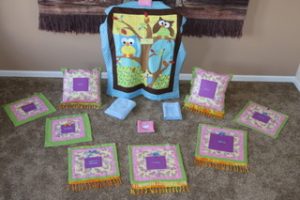
Laurie has since created blankets, pillowcases, burping cloths, and more for her family.
“The straight lines are working for me,” she says.
Noticing the Blessings
Laurie is making the most of her life. She treasures her glorious back yard and her deepened relationship with nature.
“Before, I was so busy, I never saw all the beauty around me,” she says.
She also treasures her worldwide friendships with people living with dementia, which she nourishes through video chatting and posting on Facebook. She and some chat friends recently started a virtual spiritual dementia café, where they read, discuss scripture and pray with and for people from all over the world.
Most of all she loves knowing she is giving back and helping others through her writing, speaking, radio hosting, and advocacy.
Teaming Up to Produce Great Results
Laurie and her husband work together to help her live a vibrant life. Here are their tips:
- Have a designated place and time to escape to, with no phones or email, so you can talk, cry, and really express yourself.
- Talk through the tough times. Notice when someone has a difficult day and figure out how you can improve things.
- Work together to adapt beloved activities.
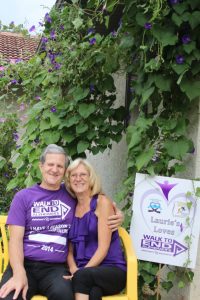
- Laugh as much as possible.
- Be thankful for every good moment.
I know you’re going to want to know more about this remarkable woman and her tips for adapting to dementia. Visit https://dementiadaze.com/about-me/
Deborah Shouse is the author of Connecting in the Land of Dementia: Creative Activities to Explore Together and Love in the Land of Dementia: Finding Hope in the Caregiver’s Journey.




